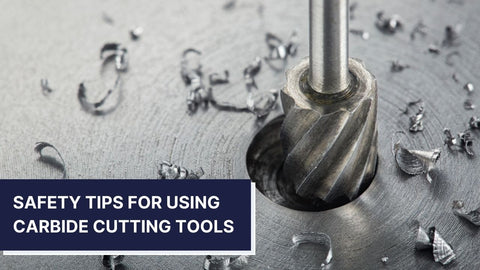Are Carbide Cutting Tools Safe to Use?

Metal cutting processes involve high energy, high spindle or cutter speeds, and high temperatures and cutting forces. During the procedure, hot, flying chips might be projected from the workpiece. Although advanced cutter materials are designed to face the high cutting forces and temperatures, still they're vulnerable to fragmentation in commission if subjected to over-stress or severe impact.
Before using any carbide cutting tool, it is essential to take the required precautions to adequately protect workers, equipment against hot, flying chips, fragmented cutting tools, and broken workpieces. Cutting tools should be fully guarded, and personal protective equipment should be used at the least times.
Safety Tips for Using Carbide Cutting Tools

Many types of cutters are used for cutting metal products made up of iron, steel, or softer, non-ferrous materials (e.g., copper, brass, aluminum). Cutters are designed for chopping materials of various sorts of products like wires, cables (electrical, coax, multi-strand), wire ropes, fencing, bolts, rods, and pre-stressed concrete wires, and strapping.
Here are the following Safety tips to consider while using carbide cutting tools:
- Hard tool materials have an outsized relative density and require special attention when the dimensions or quantity is large.
- Cutting tools generate dust and mist during grinding operations or heating. This dust and mist are often harmful when coming in touch with the eyes or skin or if substantial quantities are swallowed. Using local exhaust ventilation and respirators, a protective dust mask, glasses, gloves, etc., is vital during cutting operations.
- It is recommended to not eat in the exposed area and eat anything after thoroughly washing hands. Remove dust from the clothing by cleaning or washing, but don't shake it off.
- Cobalt and nickel contained in carbide or other cutter materials are reported as possibly carcinogenic to humans. It's also reported that cobalt and nickel dust and mist can affect the skin, respiratory organs, and heart through repeated or prolonged contact.
- Choose the right cutter for the work. Cutters are designed for a selected type, hardness, and size of the fabric.
- Cut materials straight across - keep the fabric being cut at right angles to the jaws' cutting edges.
- Prevent injury from flying metal by wrapping a gunny sack, cloth, or rag around the cutting jaws. Metal can fly when cut. The harder the metal, the farther it'll fly.
- Warn those within the area to require precautionary measures to avoid possible injury from flying metal pieces.
- Keep cutting tools in good repair.
- Adjust and lubricate cutter and moving parts daily if heavily used.
- Sharpen jaws consistent with manufacturers' instructions.
How to Handle Carbide Cutting Tools?
Follow the mentioned tips to handle carbide cutting tools safely:
- Surface conditions affect the toughness of cutting tools. Therefore, use a diamond emery wheel for finishing.
- Be careful while operating with hard tool materials as they are rigid and brittle at an equivalent time. Thus, they'll be broken by shocks and tightening with excess force.
- Hard tool materials and ferrous materials have different thermal expansion ratios. Shrinkage or swell fit products may suffer from cracks when the applied temperature is higher or less than the tool's acceptable temperature.
- Pay special attention to storing hard tool materials. The toughness of hard tool materials is lowered once they corrode thanks to coolant and other liquid.
- When brazing hard tool materials, if the temperature is too high or too low from the brazing material's freezing point, loosening and breakage may occur.
- After regrinding cutting tools, confirm that there are not any cracks.
- Machining hard tool materials on EDM may cause cracks on the surface thanks to electrons remaining after the EDM operation, leading to lower toughness. Eliminate these cracks by grinding, etc.



































































